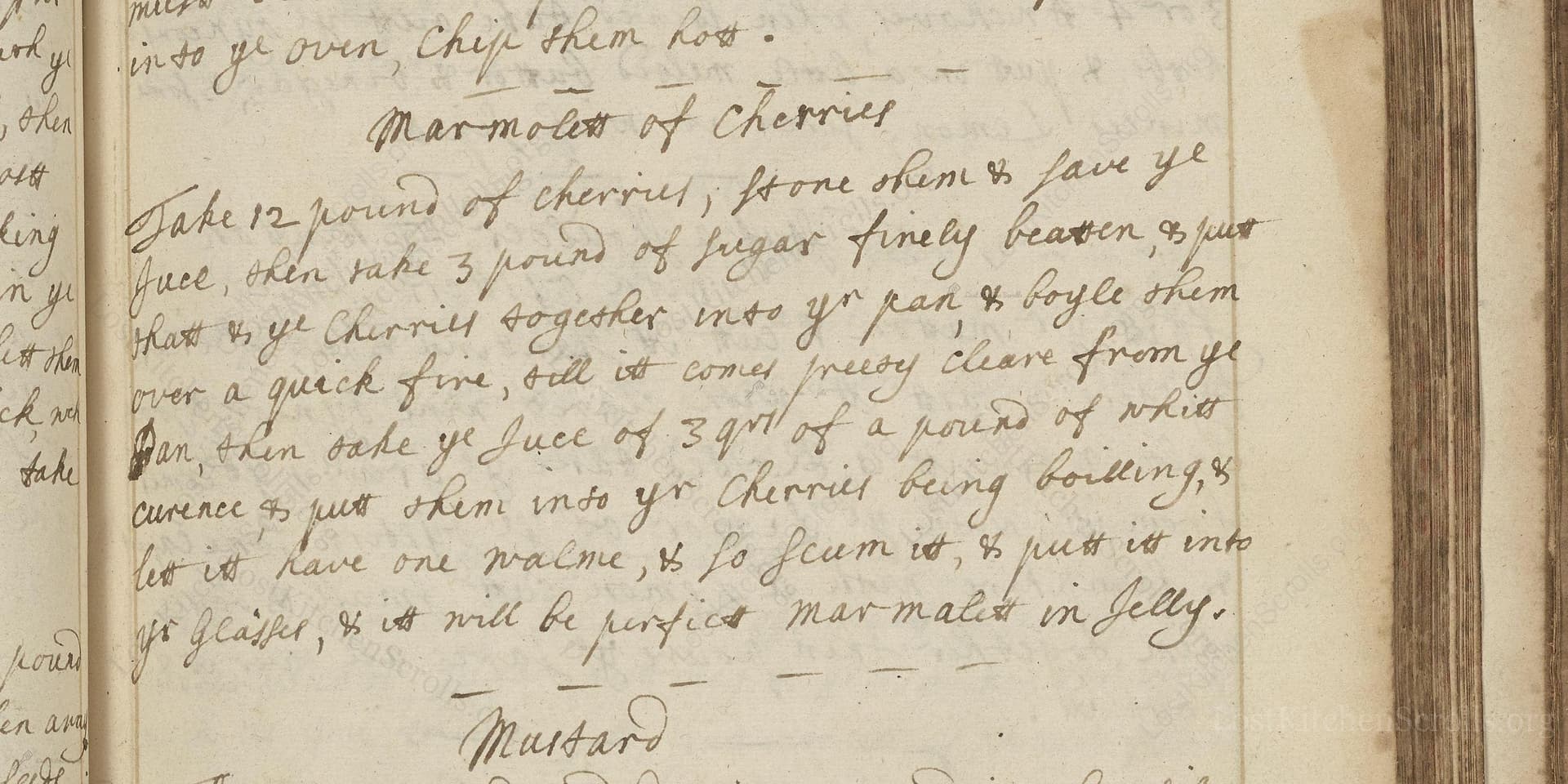Marmolett Of Cherries
From the treasured pages of Receipt book of Mary Hookes
Written by Mary Hookes

Marmolett Of Cherries
"Take 12 pound of cherries, stone them & save ye Juce, then take 3 pound of sugar finely beaten, & putt thatt & ye cherries togeother into yr pan & boyle them over a quick fire, till itt comes freey cleare from ye pan, then take ye Juce of 3 qrt of a pound of whitt currence & putt them into yr Cherries being boilling, & let itt have one walme, & so scum itt, & putt itt into yr glasses, & itt will be perfict marmalitt in Jelly."
Note on the Original Text
The recipe is written in the brisk, pragmatic prose typical of manuscript cookery books of the era. Instructions are compact and assume experience, with a focus on ingredients, method, and a minimal sense of timing or temperature—reliant on the cook’s intuition ('quick fire', 'walme', 'scum'). Spelling is mostly phonetic and variable ('ye' for 'the', 'boyle' for 'boil', 'Juce' for 'juice'), reflecting pre-standardised 17th-century English. The language is direct, omitting pleasantries or detailed measurements by modern standards.

Title
Receipt book of Mary Hookes (1700)
You can also click the book image above to peruse the original tome
Writer
Mary Hookes
Era
1700
Publisher
Unknown
Background
A delightful voyage into the kitchens of the late 17th and early 18th centuries, this book teems with forgotten flavors, aromatic recipes, and the elegant wisdom of early modern cookery. A treasure trove for culinary adventurers craving a taste of the past!
Kindly made available by
Folger Shakespeare Library
This recipe is drawn from a late 17th- to early 18th-century English manuscript attributed to Mary Hookes, a gentlewoman active around 1680. Such manuscripts were often household treasures, recording the culinary knowledge and experiments of upper-class women. Preserved fruit confections like this 'marmolett'—an early form of marmalade—were prized for their vibrant taste and ability to capture the fleeting bounty of summer for enjoyment throughout the year. The addition of acidic currant juice reflects the period's keen understanding of preservation and the creation of natural fruit jellies, well before commercial pectin was available.

Historically, the cook would have used a large copper or brass preserving pan over an open hearth or a wood/coal-fired stove, stirring with a long wooden spoon. Jelly glasses, likely made of thick hand-blown glass, would be used to store the finished marmalade. Scum would be removed with a flat skimmer. For juicing currants, a linen cloth or sieve would be deployed, squeezing out maximum juice by hand.
Prep Time
45 mins
Cook Time
45 mins
Servings
65
We've done our best to adapt this historical recipe for modern kitchens, but some details may still need refinement. We warmly welcome feedback from fellow cooks and culinary historians — your insights support the entire community!
Ingredients
- 12 lb fresh cherries, pitted (retain any juice)
- 3 lb granulated sugar
- 12 oz white currant juice (approx. 10 fl oz)—substitute with red currant juice if white currants unavailable
Instructions
- Begin by weighing 12 lb of fresh cherries and remove the stones, saving any juice that escapes.
- Place the cherries and their juice in a large, heavy-based pan.
- Add 3 lb of finely granulated sugar to the cherries.
- Set the pan over a high heat and boil the mixture, stirring frequently, until it thickens and pulls away cleanly from the sides of the pan (this should take approximately 30–45 minutes, though keep an eye on it as it cooks fast!).
- Meanwhile, juice enough white currants to yield 12 oz (about 10 fl oz) of juice.
- When the cherry mixture reaches the desired consistency, pour in the white currant juice while the mixture is still boiling.
- Allow the pan to come back to the boil (just one gentle 'walme' or simmer), then skim off any foam that rises.
- Quickly ladle the mixture into sterilised glass jars or small glasses, cool, and seal.
- The result: a gorgeously set cherry marmalade, balancing deep cherry flavour with the tartness of currants.
Estimated Calories
45 per serving
Cooking Estimates
It usually takes about 30-45 minutes to cook the cherries with sugar until thick. Preparation, including pitting cherries and juicing currants, generally takes about 45 minutes. This recipe makes about 10 standard 250 ml jars. Each serving is estimated at one tablespoon (about 20g), which contains around 45 calories.
As noted above, we have made our best effort to translate and adapt this historical recipe for modern kitchens, taking into account ingredients nowadays, cooking techniques, measurements, and so on. However, historical recipes often contain assumptions that require interpretation.
We'd love for anyone to help improve these adaptations. Community contributions are highly welcome. If you have suggestions, corrections, or cooking tips based on your experience with this recipe, please share them below.
Join the Discussion
Rate This Recipe
Dietary Preference
Main Ingredients
Culinary Technique

Den Bockfisch In Einer Fleisch Suppen Zu Kochen
This recipe hails from a German manuscript cookbook compiled in 1696, a time whe...

Die Grieß Nudlen Zumachen
This recipe comes from a rather mysterious manuscript cookbook, penned anonymous...

Ein Boudain
This recipe comes from an anonymous German-language manuscript cookbook from 169...

Ein Gesaltzen Citroni
This recipe, dating from 1696, comes from an extensive anonymous German cookbook...
Browse our complete collection of time-honored recipes



